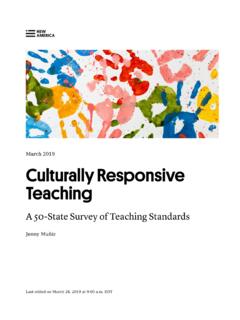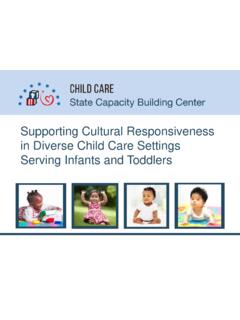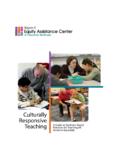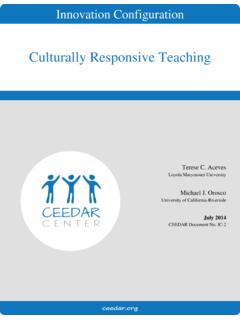Transcription of Effective Teaching Strategies for Middle School Learners ...
1 Home > Publications > Middle School Journal > Articles > November 2007 > Article 2 November 2007 Volume 39 Number 2 Pages 12-18 Effective Teaching Strategies for Middle School Learners in Multicultural, Multilingual Classrooms Barbara N. Allison & Marsha L. Rehm Middle School teachers, like all educators around the nation, are encountering classrooms comprised of an unprecedented number of students from various cultural, ethnic, and racial backgrounds. Due to the influx of immigrants entering the educational system, the number of students who speak a native language other than English has grown dramatically and will account for about 40% of the School -age population by 2040 (Berliner & Biddle, 1995). If current trends continue, almost half of our nation's School population will consist of members from non-Caucasian cultural groups by the year 2020 ( Bureau of Census, 2000).
2 The reality of a multicultural, multilingual student population dictates that educators, 87% of whom are Caucasian, must be prepared to interact and work with students who do not share the same language, culture, or national origin (Crandall, Jaramillo, Olsen, & Peyton, 2001; National Education Association, 2002). The increased diversity in the nation's classrooms has prompted much attention to the challenges associated with educating a multicultural, multilingual student population (Darling, 2005; Hodges, 2001). Some researchers believe that meeting the needs of diverse students is, and will be, even more challenging for Middle School teachers than other teachers, because they must also help students deal with the unique developmental changes that occur during this time (Johnson, 2005; McLeod, 1996).
3 As young adolescents confront a host of transitions associated with the emergence of puberty, including dramatic physical, social-emotional, and cognitive changes, they *This We Believe Characteristics zAn inviting, supportive, and safe environment zStudents and teachers engaged in active learning zMultiple learning and Teaching approaches that respond to their diversity *Denotes the corresponding characteristics from NMSA's position paper,This We Believe, for this 1 of 12 Member Access: Middle School Journal - Effective Teaching Strategies for Middle School Learners in Multicultural, Multilingual Classrooms11/6/2007 undergo transformations in relationships with parents, encounter more emotionally intense interactions with peers, and struggle with personal identity issues (Steinberg, 1981).
4 In addition, young students from varying cultural and racial backgrounds may simultaneously experience cultural conflict in the home and pressure from racially and culturally different peers at a particularly salient stage in cultural identity development (Banks, 2001; Garcia Coll, et al., 1996; Smetana & Gaines, 1999). Middle School teachers, therefore, must become educated about and skilled in using pedagogy that is sensitive and responsive to the developmental and educational needs of young adolescents from diverse racial, ethnic, and cultural backgrounds (Clauss, 2006; Darling, 2005; Davis & Thompson, 2004; Hefflin, 2002; Johnson, 2005; National Middle School Association, 2003). This article explores instructional Strategies employed by teachers in Middle School classrooms in Florida, a state in which 50% of the students in public schools are members of ethnic minority groups (Florida Department of Education, 2004).
5 The participating teachers Family and consumer sciences (FCS) Middle School teachers were targeted for this study, because FCS courses are required in all Middle schools in the state of Florida and attract a wide range of students in any given class. Further, FCS teachers typically cover an array of topics from nutrition to self-esteem and employ a variety of instructional approaches in their classes, including didactic, experiential, and laboratory forms of instruction. Finally, there was a mechanism available to access FCS Middle School teachers across the entire state ( , FCS district supervisors who agreed to assist the authors and distribute survey questionnaires to teachers). A total of 16 Middle School teachers from seven different districts across the state of Florida completed and returned the survey instrument.
6 While it cannot be assured that these 16 teachers represented all Middle School teachers in Florida, they represented districts with culturally diverse populations, including small rural and larger urban communities in Central Florida, South Florida, and the Gulf Coast regions. In addition, the participating teachers were experienced educators with an average of 15 years in the classroom and, thus, based their answers on what Strategies worked for them in the daily life of Teaching . Diversity within Florida Middle schools In the classes taught by these 16 Middle School teachers, the non-white minority representation of students averaged 48%, a number that closely matched the state average (50%). In their "most diverse class," teachers identified Latino (40%) and African American (29%) students as Page 2 of 12 Member Access: Middle School Journal - Effective Teaching Strategies for Middle School Learners in Multicultural, Multilingual Classrooms11/6/2007 largest groups represented, while 15% of the students were white.
7 The Latino group, itself, was quite diversified, with students of Puerto Rican (17%); Mexican (13%); Cuban (6%); and South American (4%) ancestry, primarily Colombian and Brazilian. Although the two primary languages spoken by students in these diverse classes were English and Spanish, languages included Chinese, Vietnamese, Russian, Haitian and Haitian Creole, German, Japanese, Portuguese, Albanian, Lithuanian, Mandarin, Romanian, and French. The extent of diversity in these Florida classes is astounding. Because of the mixture of languages, cultures, and national backgrounds, Middle School teachers confront numerous and varying pedagogical challenges on a daily basis. This portrait of diversity and the challenges confronting these teachers will inevitably extend to other Middle School teachers throughout the nation, given the rapidly growing diversity of student populations (Lessow-Hurley, 2003; Bureau of Census, 2004).
8 Identifying Effective Teaching Strategies The survey questionnaire completed by the teachers included a six-point rating scale to assess the effectiveness of a variety of Teaching Strategies , ranging from "0 (have not used)" to "5 (very highly Effective )." The scale included a total of 10 classroom practices and instructional Strategies identified and endorsed by educators in the scholarly literature as being potentially valuable and Effective with diverse Learners in culturally diverse classrooms (Davidman & Davidman, 1997; Manning & Baruth, 2004; Vaughn, Bos, & Schumm, 2003). The practices and Strategies listed were: case studies reflecting real-life experiences of diverse students; cooperative learning; dual language printed materials; field trips; guest speakers representing the cultures of the students; inviting parents to visit and participate in classroom activities; peer tutoring; role playing or skits to solve real-life problems or see others' perspectives; using alternative assessments to evaluate students; and the use of visuals.
9 Four of the 10 practices and Strategies were rated as being most Effective in diverse classrooms by these Middle School teachers (mean ratings between & ). These most Effective Strategies were use of visuals (m = ), peer tutoring (m = ), cooperative learning (m = ), and the use of alternate forms of assessment (m = ). Each of these Strategies is discussed and suggestions for how Middle School teachers can implement each in their respective classrooms are offered. Strategies and Teaching practices for diverse Learners Visuals Florida Middle School teachers rated the use of visuals such as Teaching aids and pictures as the most highly Effective Teaching strategy for multicultural and multilingual students. In the research literature, visuals have been found to be especially helpful when Teaching students whose first Page 3 of 12 Member Access: Middle School Journal - Effective Teaching Strategies for Middle School Learners in Multicultural, Multilingual Classrooms11/6/2007 is not English (Carrier, 2005; Vaughn, Bos, & Schumm, 2003).
10 Through pictures, teachers display visual stimuli that can be universally understood by all students (Curtis & Bailey, 2001). Visuals can be used in any subject area when Teaching about concepts. Furthermore, hands-on materials and visuals that students can manipulate engage a variety of senses and help to make learning more meaningful, especially for diverse students who tend to be tactile, kinesthetic Learners (Bruno, 1982; Curtin, 2006).1 As classrooms become more diverse, Middle School teachers will realize that visual aids are valuable and possibly necessary instructional tools because most diverse students are not auditory Learners (Curtin, 2006). Pictures, cartoons, maps, graphs, charts, diagrams, videos, and other multimedia resources enhance learning because they engage different senses, accommodate visual Learners , and help reinforce key ideas by presenting information in alternative formats (Carrier, 2005).















